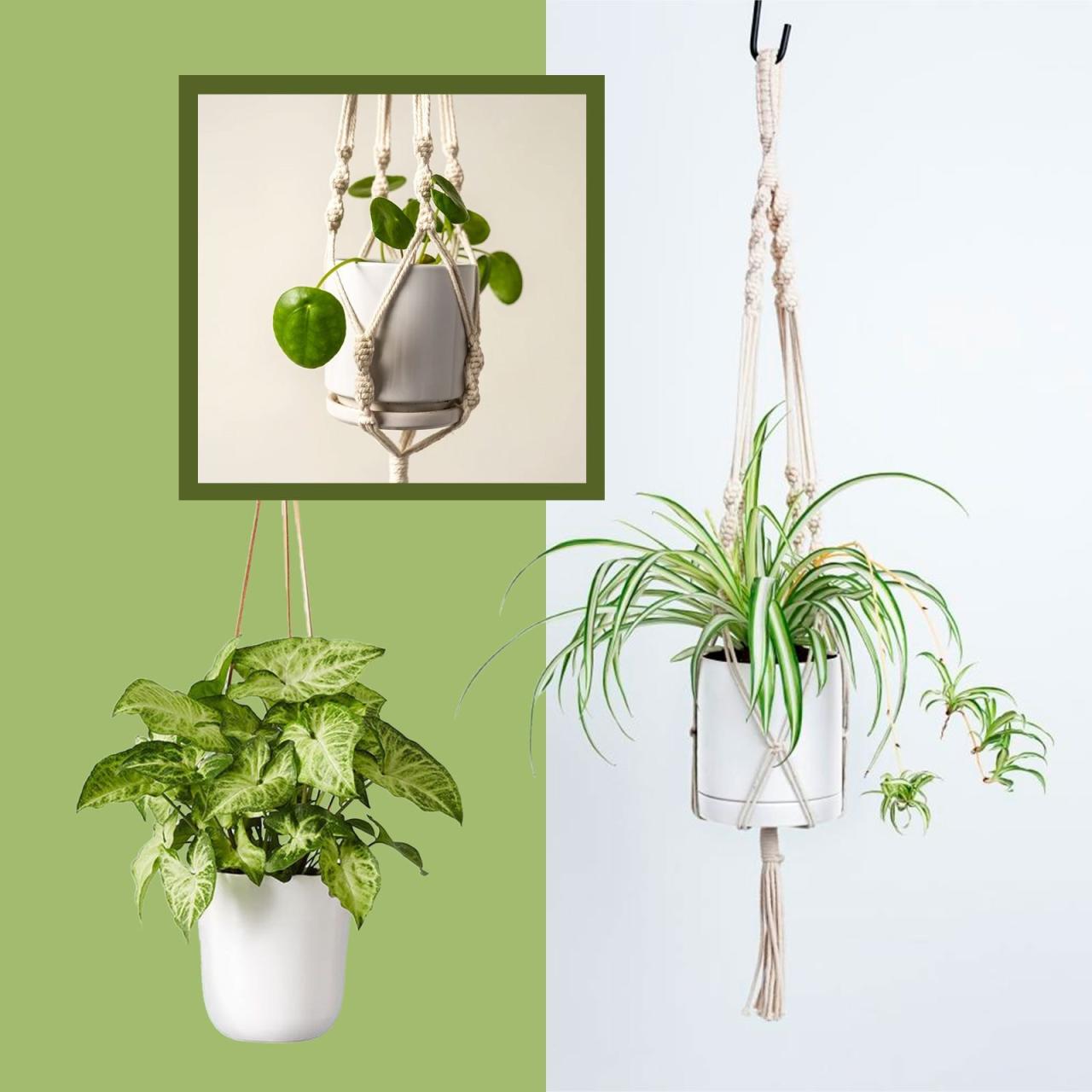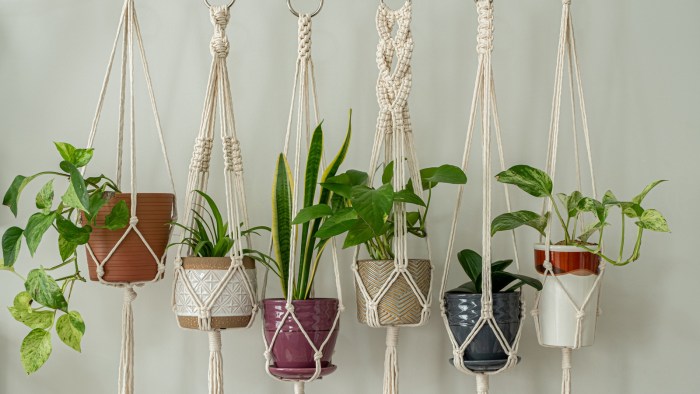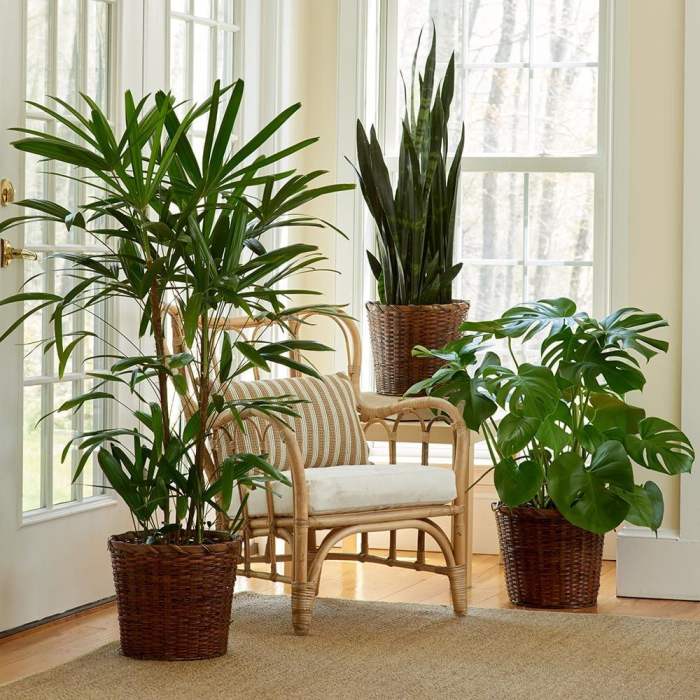Hanging plants easy care are the perfect way to add life and beauty to your home without taking up too much space. These low-maintenance plants are perfect for busy people who don’t have a lot of time to care for plants.
In this guide, we’ll provide you with everything you need to know about hanging plants easy care, from choosing the right plants to caring for them properly. We’ll also share some creative ideas for displaying your hanging plants.
Popular Easy-Care Hanging Plants

Hanging plants are a beautiful way to add greenery to your home without taking up floor space. They are also a great option for small spaces or for people who have pets or children. Many easy-care hanging plants are available, making them a great choice for busy people or those who do not have a lot of experience with plants.
Here are some of the most popular easy-care hanging plants:
Spider Plant
- Scientific name: Chlorophytum comosum
- Common name: Spider plant
- Key characteristics: Long, trailing leaves with white or yellow stripes
Pothos
- Scientific name: Epipremnum aureum
- Common name: Pothos
- Key characteristics: Heart-shaped leaves that come in a variety of colors, including green, white, and yellow
String of Pearls
- Scientific name: Senecio rowleyanus
- Common name: String of pearls
- Key characteristics: Long, trailing stems with small, round leaves that resemble pearls
Burro’s Tail
- Scientific name: Sedum morganianum
- Common name: Burro’s tail
- Key characteristics: Long, trailing stems with plump, blue-green leaves
Chain of Hearts
- Scientific name: Ceropegia woodii
- Common name: Chain of hearts
- Key characteristics: Long, trailing stems with heart-shaped leaves
Care and Maintenance Tips

Ensuring the well-being of your hanging plants is crucial to maintaining their aesthetic appeal and longevity. Specific care requirements vary depending on the plant species, so it’s essential to research and understand the needs of each plant.
Generally, hanging plants thrive in bright, indirect light and well-drained soil. Watering frequency depends on the plant’s size, type, and environmental conditions. Overwatering can lead to root rot, while underwatering can cause wilting and stunted growth.
Watering
- Check the soil moisture before watering. The top inch of soil should be dry to the touch for most plants.
- Water thoroughly until water drains from the drainage holes.
- Allow excess water to drain completely before returning the plant to its hanger.
Light Conditions
- Most hanging plants prefer bright, indirect light.
- Avoid placing plants in direct sunlight, as this can scorch the leaves.
- If your plant is not receiving enough light, it may become leggy and produce fewer flowers.
Temperature
- Hanging plants generally prefer warm temperatures between 65-80°F (18-27°C).
- Avoid exposing plants to cold drafts or extreme temperature fluctuations.
- If your plant is experiencing temperature stress, it may drop leaves or develop brown tips.
Common Problems and Troubleshooting, Hanging plants easy care
Common problems with hanging plants include yellowing leaves, wilting, and pests. Yellowing leaves can indicate overwatering, underwatering, or nutrient deficiency. Wilting can be caused by underwatering, excessive heat, or root rot. Pests such as aphids, mealybugs, and spider mites can also affect hanging plants.
To address these issues, adjust watering frequency, provide appropriate light and temperature conditions, and treat pests with insecticidal soap or neem oil.
Hanging Plant Display Ideas

Hanging plants can add a touch of greenery and life to any room. They can be used to create a vertical garden, add height to a space, or simply bring a bit of nature indoors. There are endless possibilities when it comes to displaying hanging plants, so get creative and have fun with it!
Unique Plant Arrangements
One of the best things about hanging plants is that they can be arranged in so many different ways. You can create a lush, cascading display by hanging multiple plants from the same hook. Or, you can create a more subtle look by hanging a single plant from a thin wire or chain.
Hanging plants are a great way to add greenery to your home, and they’re relatively easy to care for. But what if you want to plant them in the ground? Can you plant hanging plants in the ground ? The answer is yes, but there are a few things you need to keep in mind.
First, make sure that the plant is suitable for outdoor planting. Some hanging plants, such as ferns and ivy, are not tolerant of cold weather and will need to be brought indoors during the winter. Second, choose a location that gets plenty of sunlight but is also protected from the wind.
And finally, be sure to water your plants regularly, especially during the hot summer months.
You can also use hanging plants to create a living wall by attaching them to a trellis or other vertical structure.
Hanging Methods
There are also a variety of different ways to hang plants. You can use traditional hooks or brackets, or you can get creative with macrame, wire, or even old picture frames. If you’re hanging a plant from a high ceiling, you can use a pulley system to make it easier to reach.
No matter how you choose to hang your plants, make sure they are secure and won’t fall down.
Hanging plants are a great way to add greenery to your home without taking up too much space. They’re also relatively easy to care for, especially if you choose plants that are known for their hardiness. One type of hanging plant that is particularly easy to care for is the self-watering hanging basket.
These baskets have a reservoir that holds water and slowly releases it into the soil, so you don’t have to worry about watering them as often. Self-watering hanging baskets are available in a variety of styles and sizes, so you can find one that fits your needs and décor.
And because they’re so easy to care for, they’re a great option for busy people or those who don’t have a lot of time to spend on gardening.
Benefits of Hanging Plants: Hanging Plants Easy Care
Incorporating hanging plants into indoor spaces offers a myriad of benefits, ranging from aesthetic enhancements to environmental and psychological improvements.
Hanging plants are a great way to add life and greenery to your home, and they’re surprisingly easy to care for. Many hanging plants are well-suited for outdoor use, such as hanging plants for outside . These plants can tolerate a variety of conditions, making them a good choice for beginners.
And because they’re easy to care for, you can enjoy their beauty for years to come.
Hanging plants serve as natural air purifiers, effectively removing toxins and pollutants from the air. They release oxygen and absorb carbon dioxide, contributing to a healthier indoor environment. This air purification quality makes them particularly beneficial in homes and offices, where air quality can be compromised by synthetic materials and electronics.
Psychological Benefits
Beyond their air-purifying capabilities, hanging plants have been shown to have positive psychological effects. Studies have demonstrated that exposure to plants can reduce stress, improve mood, and enhance overall well-being. The presence of greenery in the indoor environment creates a calming and relaxing atmosphere, reducing feelings of anxiety and promoting a sense of tranquility.
Aesthetic Benefits
Hanging plants add a touch of beauty and elegance to any space. Their cascading foliage and vibrant colors create a lush and inviting ambiance. They can be used to soften sharp corners, add height to rooms, and create a sense of depth.
Hanging plants can also be used to define specific areas or create focal points within a room.
DIY Hanging Plant Projects

Creating your own hanging plant holders or macrame hangers adds a personal touch to your indoor greenery. With a few simple steps and inexpensive materials, you can craft unique and stylish displays for your plants.
These projects are not only fun and rewarding but also a great way to upcycle materials and add a touch of bohemian flair to your home.
Macrame Plant Hangers
Macrame plant hangers are a classic and versatile way to display your plants. Here’s a step-by-step guide to make your own:
- Gather your materials: macrame cord, scissors, measuring tape, and a wooden ring.
- Cut four equal lengths of macrame cord and attach them to the wooden ring using a lark’s head knot.
- Divide the cords into two groups of two and tie a square knot at the bottom of each group.
- Repeat step 3, alternating between the two groups, until you reach the desired length.
- Gather all eight cords and tie a square knot at the top to create a loop for hanging.
Final Conclusion
Hanging plants are a great way to add beauty and style to your home. They’re also a great way to improve your air quality and reduce stress. So what are you waiting for? Get started today and enjoy the benefits of hanging plants easy care.
Detailed FAQs
What are the most popular hanging plants easy care?
Some of the most popular hanging plants easy care include pothos, spider plants, and philodendrons.
How often should I water my hanging plants?
Most hanging plants need to be watered about once a week. However, you may need to water them more often if they are in a bright, sunny location.
What are some creative ways to display hanging plants?
There are many creative ways to display hanging plants. You can hang them from the ceiling, from a shelf, or from a macrame hanger.